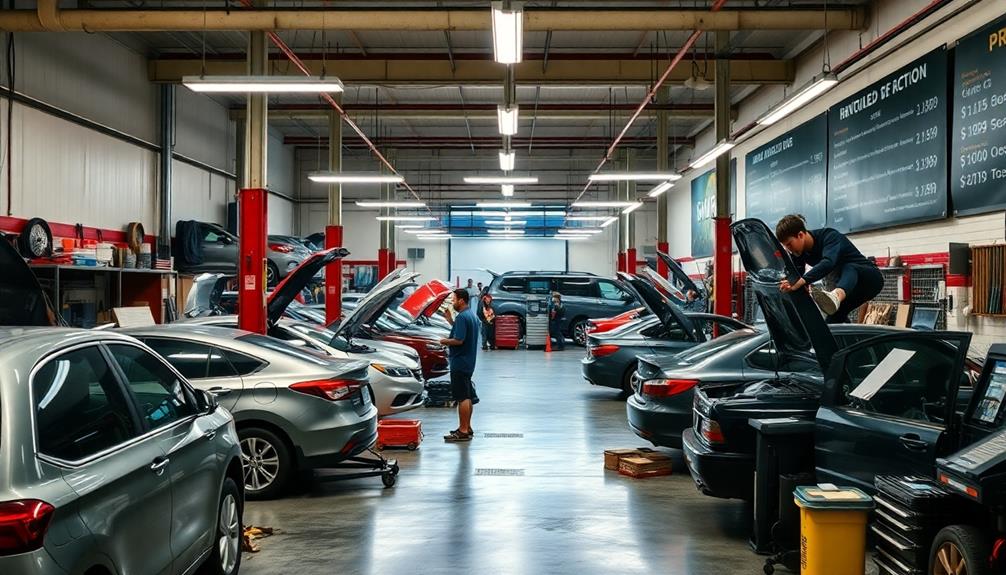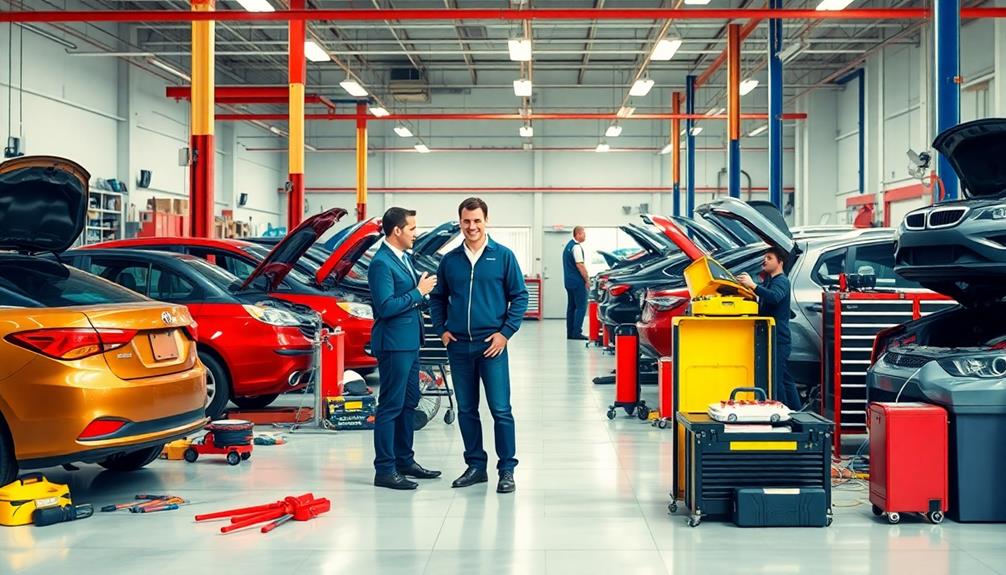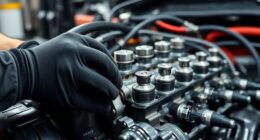The automotive repair industry is currently valued at about $789.8 billion and is set to reach $1.6 trillion by 2031, indicating robust growth. This surge is largely driven by an increase in vehicle registrations and the average age of cars on the road. As vehicles become older, the demand for repairs and maintenance will only rise. With around 282,000 companies in the U.S. alone, competition is fierce. Whether you're a consumer or a professional in the field, understanding this industry's potential is vital for success. Discover how various factors influence this dynamic market further.
Key Takeaways
- The automotive repair industry was valued at approximately $789.8 billion in 2021.
- It is projected to reach $1.6 trillion by 2031, indicating robust growth.
- The North American market size was around $78.4 billion in 2022.
- The average annual revenue per auto repair shop is estimated at $1,226,000.
- Increased vehicle registrations and aging vehicles are driving demand for repair services.
Overview of the Industry Value
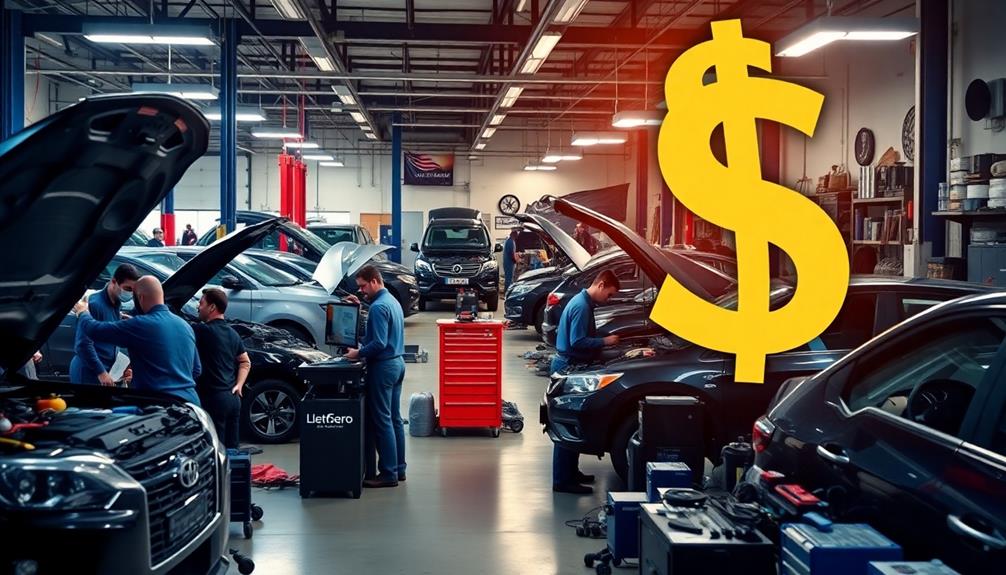
The automotive repair industry is a massive market, valued at around $789.8 billion in 2021 and projected to soar to $1.6 trillion by 2031. This growth reflects a compound annual growth rate (CAGR) of 7.6% from 2022 to 2031, highlighting the industry's robust potential.
In North America alone, the automotive repair market size reached approximately $78.4 billion in 2022, driven largely by maintenance services and repairs.
With around 282,637 companies in the U.S. automotive repair sector, employing over 614,433 workers, the market demonstrates a solid presence. Each auto repair shop generates an average annual revenue of about $1,226,000, showcasing the revenue generation capacity of this industry.
Factors such as increased vehicle ownership and rising disposable income contribute considerably to the repair industry market share. Additionally, an aging vehicle fleet necessitates more frequent vehicle maintenance, fueling demand for repair services.
As you consider the automotive repair market's value, it's clear that this industry plays a vital role in the economy, providing essential services to vehicle owners and highlighting its importance in everyday life. The demand for maintenance and repair services continues to grow as more vehicles remain on the road for extended periods, further driving the need for skilled technicians. This sustained demand directly influences automotive repair business profitability, as shops that can efficiently meet the needs of their customers tend to see steady growth. Additionally, advancements in vehicle technology present new opportunities for businesses to expand their services and increase profitability in this evolving market.
Key Growth Factors
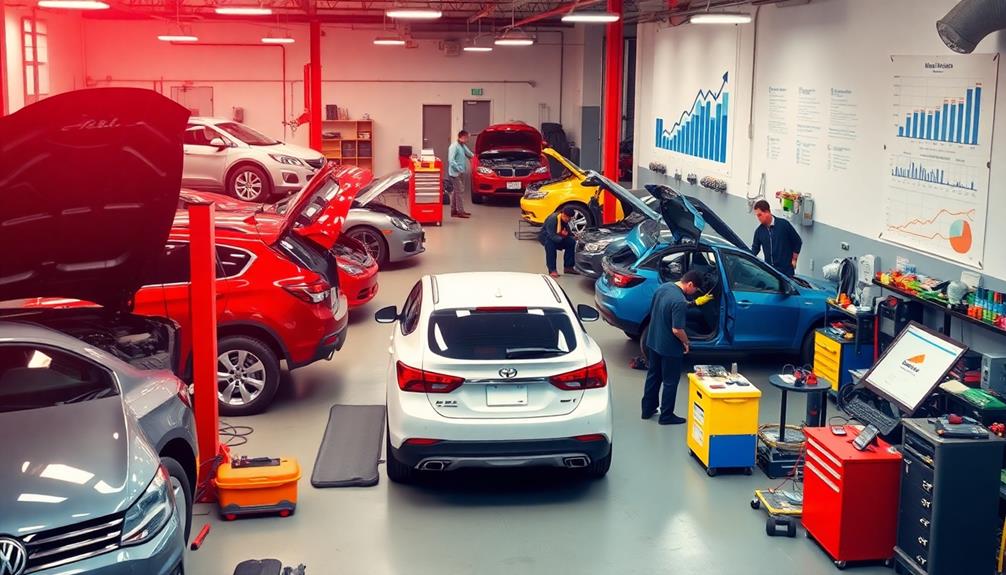
Several key growth factors are driving the automotive repair industry forward, making it an essential sector in today's economy. One major factor is the increased number of motor vehicle registrations coupled with an average vehicle age of 12.3 years. As vehicles age, the demand for maintenance and repair services naturally rises, contributing considerably to the industry's growth.
Moreover, supply chain issues and improvements in vehicle quality have led to a decline in new vehicle sales, pushing consumers to invest in the repair of their older cars. This trend enhances the need for professional maintenance services, especially as rising disposable incomes allow more consumers to prioritize expert care over DIY fixes.
Additionally, the increasing average miles driven per vehicle intensifies the wear and tear, resulting in heightened maintenance requirements. As these factors combine, they create a robust environment for the auto repair industry to thrive.
With a projected market value of $1.6 trillion by 2031, you can see how these growth factors are positioning the automotive repair sector for continued expansion, ensuring its vital role in the economy.
Major Repair Services

As the automotive repair industry continues to grow, understanding the major repair services is key to recognizing how shops can generate revenue.
Oil changes stand out as the most frequent maintenance service, expected to bring in an impressive $9.9 billion in 2022. This consistent demand helps repair shops maintain a steady income while providing essential auto repairs for vehicle owners.
On the other hand, major repairs, like engine replacements, represent a significant revenue opportunity, despite being less common. With costs ranging from $5,000 to over $20,000, these services can dramatically boost a shop's bottom line.
Brake pad replacements and engine tune-ups are also critical repair services that guarantee vehicle safety and performance, further contributing to shop revenues.
Incorporating a blend of both major repairs and high-volume services helps shops diversify their income streams. While oil changes and brake jobs provide regular cash flow, major repairs offer the potential for substantial financial gains.
For auto repair businesses, balancing these services is crucial for long-term success in the ever-expanding automotive repair landscape.
Costly Repair Insights

Many vehicle owners underestimate the potential costs associated with major repairs, which can quickly escalate into financial burdens.
One of the most significant expenses you'll face is engine replacement, ranging from $5,000 to over $20,000. While auto repair shops often thrive on high-volume, lower-cost repairs like oil changes and brake jobs, it's vital to recognize the importance of timely maintenance and repairs to avoid costly surprises.
Consider these insights:
- The average cost for a check engine light warning is about $387, highlighting the need for prompt diagnostics.
- Routine maintenance can prevent major repairs, saving you money in the long run.
- Parts and labor costs heavily influence repair expenses, making effective inventory management essential for auto repair shops.
- Major repairs may be less frequent, but they can yield significant profits for shops.
Electric Vehicle Impact

The rise of electric vehicles (EVs) is transforming the automotive repair landscape, creating both challenges and opportunities for repair shops. As EVs are projected to dominate the market by 2028, you'll need to adapt your services to include EV-specific maintenance and repairs. This shift means that while you'll still service essential components like brakes and tires, you'll also require new training and equipment for specialized EV servicing.
With the global automotive repair industry expected to grow from approximately $789.8 billion in 2021 to $1.6 trillion by 2031, the annual growth rate reflects the increasing importance of EVs in consumer preferences. This change offers a significant chance for auto repair shops to expand their business by embracing new technologies and providing tailored services.
However, keep in mind that as EVs become more prevalent, the demand for traditional auto repair services may decrease. This alteration could affect revenue distribution within the industry, so it's vital to stay ahead of the curve.
Employment and Wages
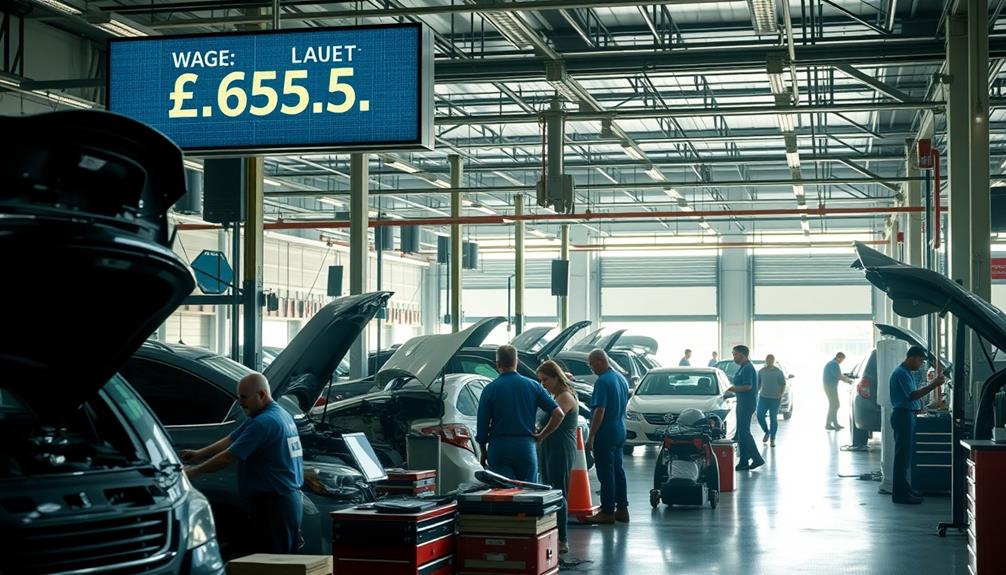
In the automotive repair industry, you'll find over 614,000 job opportunities that are expected to grow by 7% by 2030.
Wages vary widely based on your specialization and experience, with skilled technicians earning considerably more.
Plus, there are training programs available to help you enhance your skills and boost your earning potential.
Employment Opportunities Growth
Employment in the automotive repair industry is booming, with over 614,000 individuals currently working as mechanics, technicians, and support staff. As the industry continues to evolve, employment opportunities are anticipated to rise with a projected annual growth rate of 7% by 2030. This growth reflects an increasing demand for skilled technicians in repair shops, as vehicles become more technologically advanced.
Here are some key points to evaluate:
- The automotive repair sector offers a range of roles, from entry-level positions to specialized technicians.
- Training programs are available to help you develop the necessary skills and stay competitive in the job market.
- The industry's growth means more job security and opportunities for advancement.
- Skilled labor is in high demand, ensuring that your expertise will be valued.
With an average hourly wage of around $20, potential annual earnings can reach approximately $40,000.
As the automotive repair industry continues to thrive, now's the perfect time to explore the various pathways available and secure your future in this dynamic field.
Don't miss out on these exciting employment opportunities!
Wage Variations by Specialization
Wage variations in the automotive repair industry can be significant, depending on specialization and experience. On average, auto repair employees earn around $20 per hour, translating to potential annual earnings of about $40,000.
However, certain roles, like specialized mechanics and technicians, can command higher wages due to the demand for specific skills. For instance, those who focus on advanced diagnostics or hybrid vehicle repairs often earn more than general mechanics.
This can create a disparity in wages, with specialized technicians enjoying competitive pay compared to workers in other service industries. As the automotive sector continues to grow, employment opportunities are expected to rise, leading to anticipated wage increases driven by the growing demand for skilled labor.
If you choose to enhance your skills through training programs, you might find that your earning potential increases even further. By focusing on in-demand specializations, you can position yourself for higher wages and better job prospects in the automotive repair industry.
Ultimately, understanding these wage variations can help you make informed decisions about your career path and specialization within the field.
Industry Training Programs Available
The automotive repair industry's growth has led to a variety of training programs designed to enhance your skills and career prospects.
These industry training programs focus on essential areas like maintenance, body repairs, and advanced automotive technologies, helping you stay competitive in a rapidly evolving field.
With over 614,000 individuals employed in this sector, the demand for skilled technicians is increasing, making it a prime time to boost your expertise.
Consider these benefits of participating in training programs:
- Skill Enhancement: Gain hands-on experience that prepares you for real-world challenges.
- Career Advancement: Position yourself for promotions and specialized roles in the repair business.
- Increased Wages: Higher skill levels can lead to better pay, with average hourly wages around $20.
- Employment Opportunities: As the demand for services grows, so do job openings for trained professionals.
Market Trends and Projections
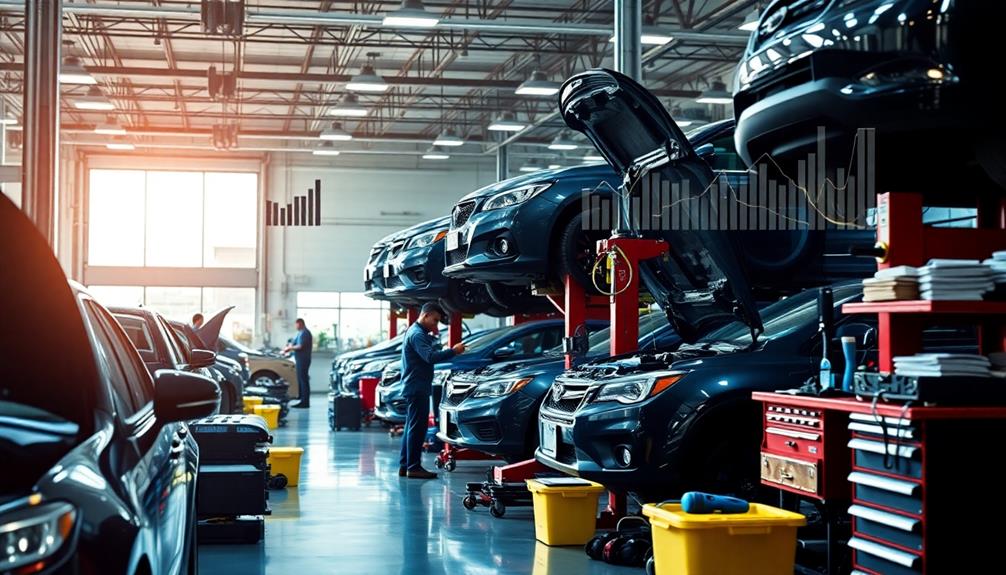
In light of the automotive industry's rapid evolution, market trends and projections reveal a robust future for the repair sector. The global automotive repair industry, valued at approximately $789.8 billion in 2021, is projected to reach $1.6 trillion by 2031, showcasing a compound annual growth rate (CAGR) of 7.6%. In the U.S. alone, the auto repair industry generated around $133 billion in revenue in 2022, with independent garages handling over 85% of bodywork services.
As vehicles age—averaging about 13.1 years—the demand for automotive repair is shifting toward maintenance and innovative solutions. You'll notice a rise in predictive maintenance and data analytics, enhancing service reliability.
Here's a snapshot of current market trends:
| Year | Estimated Value (USD) | CAGR (%) |
|---|---|---|
| 2023 | 825 billion | 10.2 |
| 2025 | 900 billion | 9.8 |
| 2031 | 1.6 trillion | 7.6 |
These trends indicate that consumer preferences are evolving, and the automotive repair sector is gearing up for a significant transformation, particularly with the introduction of new vehicles and maintenance programs.
Frequently Asked Questions
How Big Is the Automotive Repair Market?
The automotive repair market's size reflects its importance in the economy. With thousands of companies and a strong workforce, you'll find ample opportunities for services, making it a crucial industry for both providers and consumers alike.
How Much Is the Automotive Service Industry Worth?
You'll find the automotive service industry worth billions, with significant growth projected. It's thriving, driven by increasing vehicle numbers and consumer demand for maintenance. Engaging in this sector can offer substantial opportunities for investment and employment.
How Big Is the Repair Service Market?
You'll find the repair service market is significant, driven by increased vehicle ownership and an aging fleet. As more people invest in their vehicles, the demand for quality repair services continues to grow rapidly.
What Is the Profit Margin for Auto Repair?
Ever wondered how much money you could make fixing cars? The average profit margin for auto repair shops is around 26%, but it can vary widely, influenced by factors like labor and operating costs.
Conclusion
In the vast ocean of the automotive repair industry, understanding its value and trends helps you navigate the waters of ownership and maintenance. As the landscape evolves, driven by electric vehicles and new technologies, staying informed is your lifeboat against unexpected repair costs. With growth on the horizon, knowing the ins and outs of this industry not only protects your wallet but also guarantees your ride remains smooth and safe on the road ahead.


